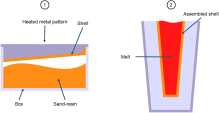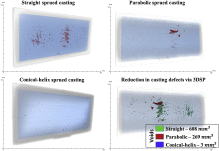Michail Papanikolaou, Prateek Saxena
Sustainable Manufacturing Systems Centre, Manufacturing Theme, Cranfield University, Cranfield, United Kingdom
Available online 1 April 2021.
Abstract
Since the 1980s, the evolution of the computing power as well as the advances in numerical modeling techniques have allowed for the development of accurate casting simulation solutions. Although casting processes involve a series of diverse phenomena such as turbulent flow, porosity formation, and various time scales, modern simulation packages are capable of accurately modeling both the filling and solidification stages of the process. Thus foundry engineers can nowadays predict the characteristics of the final cast products such as residual stresses and defective locations without having to perform numerous time-consuming trial-and-error experiments. On the other hand, one of the applications undergoing intense investigation during the last few decades has been the successful implementation of integrated modeling, simulation, and optimization frameworks in manufacturing processes. Most of the case studies implemented focus on the optimization of three main process characteristics closely related to sustainability: (1) yield, (2) energy efficiency, and (3) product quality. The aim of this chapter is to provide an overview of the modeling techniques and optimization frameworks, which have been successfully applied to the simulation of casting processes with respect to the aforementioned process characteristics.
Korea Abstract
1980 년대 이후로 계산 능력의 발전과 수치 모델링 기술의 발전으로 정확한 주조 시뮬레이션 솔루션을 개발할 수 있었습니다. 주조 공정에는 난류, 다공성 형성 및 다양한 시간 척도와 같은 일련의 다양한 현상이 포함되지만 최신 시뮬레이션 패키지는 공정의 충전 및 응고 단계를 모두 정확하게 모델링 할 수 있습니다.
따라서 파운드리 엔지니어는 오늘날 많은 시간이 소요되는 시행 착오 실험을 수행하지 않고도 잔류 응력 및 결함 위치와 같은 최종 주조 제품의 특성을 예측할 수 있습니다. 반면에 지난 수십 년 동안 집중 조사를 받은 애플리케이션 중 하나는 제조 프로세스에서 통합 모델링, 시뮬레이션 및 최적화 프레임 워크를 성공적으로 구현 한 것입니다.
구현된 대부분의 사례 연구는 지속 가능성과 밀접하게 관련된 세 가지 주요 프로세스 특성 인 (1) 수율, (2) 에너지 효율성 및 (3) 제품 품질의 최적화에 중점을 둡니다.
이 장의 목적은 앞서 언급 한 공정 특성과 관련하여 주조 공정 시뮬레이션에 성공적으로 적용된 모델링 기법 및 최적화 프레임 워크에 대한 개요를 제공하는 것입니다.






Keywords
Numerical modeling, casting, optimization, artificial neural networks, sustainability